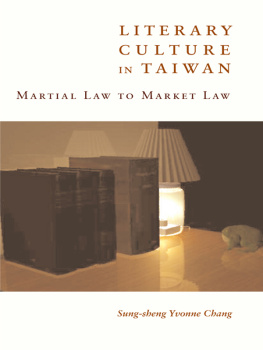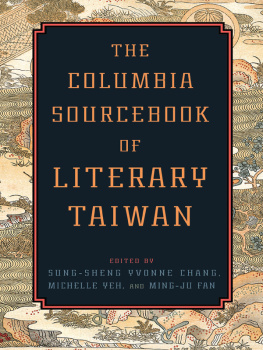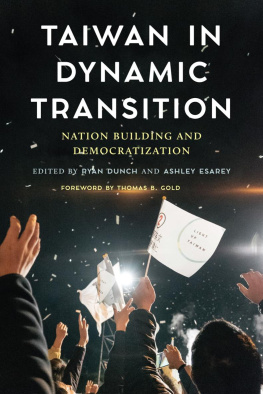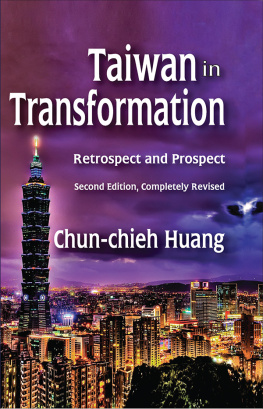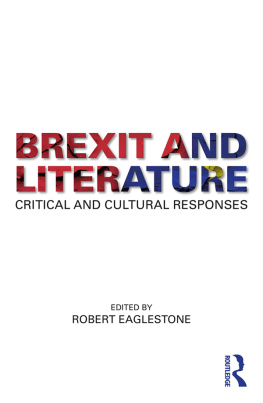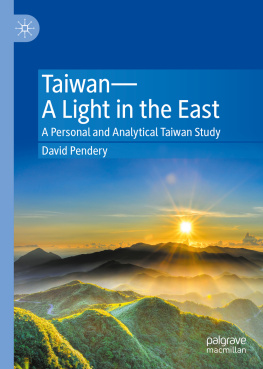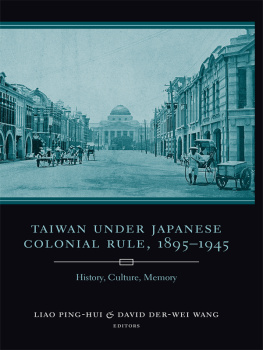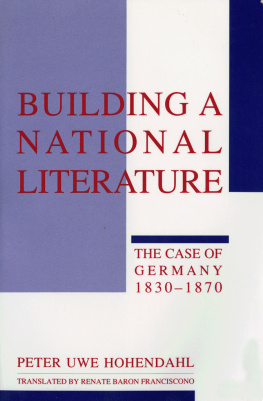LITERARY CULTURE IN TAIWAN

LITERARY CULTURE IN TAIWAN

Martial Law to Market Law
Sung-sheng Yvonne Chang
COLUMBIA UNIVERSITY PRESS NEW YORK
Columbia University Press wishes to express its appreciation for assistance given by the Chiang Ching-kuo Foundation for International Scholarly Exchange and the University of Texas in the publication of this book.

COLUMBIA UNIVERSITY PRESS
Publishers Since 1893
NEW YORK CHICHESTER, WEST SUSSEX
cup.columbia.edu
Copyright 2004 Columbia University Press
All rights reserved
E-ISBN 978-0-231-50712-7
Library of Congress Cataloging-in-Publication Data
Chang, Sung-sheng, 1951
Literary culture in Taiwan : martial law to market law / Sung-sheng Yvonne Chang.
p. cm.
Includes bibliographical references and index.
ISBN 0231132344 (cloth)
1. Chinese literatureTaiwan20th centuryHistory and criticism. I. Title.
PL3031.T3C4468 2004
895.1'509951249dc22
2003068776
A Columbia University Press E-book.
CUP would be pleased to hear about your reading experience with this e-book at .
C ONTENTS
This historical overview is for readers unfamiliar with Taiwans modern era. Taiwan experts, go directly to the introduction.
Taiwan, an island 90 miles off the southern coast of mainland China, saw an influx of Han Chinese settlers from Chinas Fujian (Fukien) and Guangdong (Kuangtung) provinces in the 1600s, and was formally incorporated into the Qing Empire as a prefecture of Fujian province in 1684. In the second half of the nineteenth century, China suffered a series of losses to western and Japanese imperial aggression. After losing the first Sino-Japanese war in 1895, the Qing court ceded Taiwan to Japan, already modernized and newly powerful thanks to the Meiji Restoration. During 50 years of colonial rule, the Japanese exploited Taiwans agricultural wealth, but also built a modern industrial infrastructure on the island and introduced modern institutions, including a new public education system. One far-reaching consequence of these changes was that when Taiwan was returned to China at the end of the Second World War, most educated Taiwanese spoke and wrote in Japanese.
The colonial period was mostly orderly, but tensions rose after Japan invaded China in 1937, and again when it expanded the war zone to the Pacific in 1941. Tens of thousands of young Taiwanese were drafted to support Japans war efforts in Southeast Asia and China; many never returned. The banning of Chinese-language publications early in this period and the imposition of wartime mobilization programs, including the Kominka (Japanization or Imperialization) campaign, brought to the surface latent tension between the colonizers and the colonized.
The retrocession of Taiwan to the Nationalist-controlled Republic of China in 1945 came with its own difficulties. The Nationalists (Kuomintang, or KMT) used Taiwans resources to support their fight against the Communists on the mainland, and failed miserably in their early attempts at governing the recovered territory. Discontent over rampant inflation, official corruption, and administrative incompetence erupted into spontaneous rioting that spread throughout the island in February 1947. The new government summoned soldiers from the mainland and brutally suppressed the riots, killing many thousands of Taiwanese, including a large number of the social elite. The February 28 Incident, as it came to be known, has played a divisive role in Taiwans society and politics ever since.
In 1949, the Nationalist regime, led by Generalissimo Chiang Kai-shek, lost its war with the Communists on the mainlandnow declared the Peoples Republic of China (PRC)and retreated to Taiwan, where it continued to reign in the name of the Republic of China. During the massive retreat of 1949, around two million people relocated from various parts of the Chinese mainland to Taiwan. These new arrivals became known as mainlanders, as opposed to earlier settlers, who are often called native Taiwanese. Conflict and cooperation between these two population groups continue to play a prominent role in the cultural configurations that this study explores.
The Nationalists resettlement in Taiwan was consolidated when, following the outbreak of the Korean War, the United States decided to help defend and develop the island nation-state as an anti-Communist outpost in East Asia, initially by sending the Seventh Fleet into the Taiwan Strait. Meanwhile, the Nationalist government declared martial law and, on Chiangs orders, earnestly prepared to launch a counterattack and regain the mainland, a plan unlikely to succeed and not included in the U.S. Cold War agenda. The two Chinese regimes separated by a narrow strait achieved a de facto truce after an aborted attempt by the PRC to force Taiwan into submission by heavily bombarding two offshore islands, Jinmen (Quemoy) and Mazu (Ma-tsu), in 1958.
By suppressing civil rights and freedom of speech in the immediate post1949 decadesan era known as the White Terrorthe Nationalist regime maintained social stability while instituting successful economic and educational programs that led to accelerated growth, followed by remarkable prosperity. However, the sociocultural order sustained by authoritarian rule began to erode in the early 1970s, when Nixon visited China (1971) and Taiwan was ousted from the United Nations, events that undermined the Nationalist regimes claim to be the sole legitimate Chinese government. When Chiang Ching-kuo (CCK), eldest son of Chiang Kai-shek, took over the reins of power after his father died in 1975, he faced grave challenges on both the domestic and the diplomatic fronts. Overall, Chiang Ching-kuos era (the mid-1970s to the late 1980s) was more enlightened, a period of soft-authoritarian rule marked by serious efforts to nativize the ruling KMT regime by means of a peaceful transition of power from mostly mainlander administrators to more native Taiwanese. The leadership also made pragmatic adjustments to Taiwans newly isolated position in the international community. This, and the impressive performance of capable KMT technocrats, helped make Taiwan a growing economic force on the world stage and a leader among East Asias remarkable group of Newly Industrialized Countries (NICs).
Prosperity changed things. In the 1970s and 1980s Taiwans new affluence, a rising middle class, and a less repressive, more open-minded ruling regime fostered political opposition, especially among native Taiwanese tired of the mainlander populations hegemony and eager for a more democratic society. The 1979 Kaohsiung Incident (or Meilidao Incident) was a turning point for political opposition. A clash in the southern city of Kaohsiung between political demonstrators at an International Human Rights Day rally and KMT troops sent to stop the demonstration resulted in the arrests of fifteen of Taiwans most important opposition leaders, a group of writers and intellectuals organized around the Meilidao [Formosa] magazine. The well-publicized trial and sentencing of these political activists in military court caused a great stir, reminding people of the lack of real democracy in Taiwan under martial law.
The Kaohsiung Incident was followed by a decade-long struggle between the mainlander-controlled KMT and dangwai (outside the party) political forces. The Nationalist government was forced to make significant concessions. In 1986, a homegrown political party, the Democratic Progressive Party (DPP), was founded in Taiwan. Then, in 1987, shortly before the death of Chiang Ching-kuo in January 1988, martial law was lifted after 38 years. Radical intellectual ferment, militant political protests, and grass-roots civilian demonstrations made the last years of the 1980s at once tumultuous and euphoric.
Next page
